|
|
A
Close-up View of the Wildflower (Coreopsis tinctoria) |
|
|
A
Close-up View of the Wildflower (Coreopsis tinctoria) |
This
very colourful wildflower is not common in my vicinity. The only
small patch that I have come across grows in the partial shade, beside
a small stream that commonly overflows its banks during heavy
rains. Although all of these Coreopsis plants grow in an area
less than four square metres, there is amazing diversity in the
appearance of the flowers. Blooms may be yellow, red, purple or a
combination of these colours.
Plains Coreopsis belongs to the Aster
family whose members possess composite
flower-heads, usually containing both ray and disk flowers. The blooms of
this wildflower bear some resemblance to those of another member of the
family, the daisy. Each flower head has a diameter of from two to
four centimetres.
The genus name Coreopsis
comes from the Greek for “bug”, and refers to the plants’ seeds which
when dried are flat and resemble the same. The species name tinctoria refers
to the colourful appearance of the blooms, and is given to plants
involved in staining or dyeing processes.
Most plants near the stream grow to about 40 centimetres in height and
possess very fragile looking, but actually amazingly strong
stems. Plants bloom until the beginning of October in Southern
Ontario.
The ray flowers (petals), of which there are usually eight, are
sometimes bent backwards slightly, as in the first image in the
article, or forwards as in the image below.

Notice the small diameter of the stems compared to that of the
flower-heads. An unopened bud can be seen in the upper left
corner of the image.

At this early stage of development, the bud is protected by an outer
sheath of specialized leaves called phyllaries. They can be seen
to be light green with brown edges.

Later, as the bud begins to open, these phyllaries have turned a deep
purple-brown colour. Notice the darker veins in the unfurling
yellow petals.

Some Plains Coreopsis plants’ ray flowers have a much larger purple
area than others. Compare the two images below with the first
image in the article to see the difference.


The view of the back of a flower-head is interesting. The series
of modified leaves (phyllaries)
beneath, (or behind) the flowers is called the involucre. In this species,
the involucre is said to be dimorphic
because there are two forms of phyllary present. The outer series
is composed of eight short green phyllaries, while the inner series has
eight larger reddish-green, finely striped phyllaries.


Once the flower-head has completely opened up, the outer ray flowers
begin to bloom first. The central area of unopened disk flowers
appears dark purple.

A little later, the outermost disk flowers begin to bloom. I am
always amused by the intricate terminology that “experts” use to
describe a scientific phenomenon in order to keep “amateurs” in awe of
their expertise. One nameless reference describes Coreopsis disk
flowers as having a
“Disk to 8mm
broad, subglobose. Corolla tube to 3mm long, yellow-orange, deep purple
at apex, 4-lobed, fertile. Style bifurcate, orange at apex, exserted.
Achene 1.8mm long in flower, flattened, glabrous. Pappus absent or a
minute crown.”
What?! (I shouldn’t really complain, since my area, chemistry,
uses at least, if not more complex terminology. Could you write
the structural formula for 1,2-dichloro-3-methyl-5-ethyl benzene?
Enough said! If things were explained simply, teachers like me
would be less necessary. Horror of horrors!!)
Notice that each disk flower in the image below has a tiny yellowish
tube that opens up to form a narrow ring of four purple petals that are
fused together, and thus difficult to distinguish. A tube formed
by fused anthers projects out of each flower.


Eventually, all of the disk flowers open, and the mature composite
flower-head is revealed.

There seems to be a gradual opening up of the ends of the fused
anthers, revealing more pollen at each stage.


If one of the disk flowers is carefully removed from a flower-head like
the one below,

and a microscope is used to magnify the top of the flower, it
looks like this. Copious amounts of spherical yellow pollen
collects at the top of the anthers
(male, pollen producing structures).

The details in the tiny tip of one of the disk flower petals can be
seen in the following image.

In the image below, on the left, several stigmas (female, pollen accepting
structures) can be seen. The more highly magnified image of some
stigmas, on the right, reveals that they have two curled lobes.
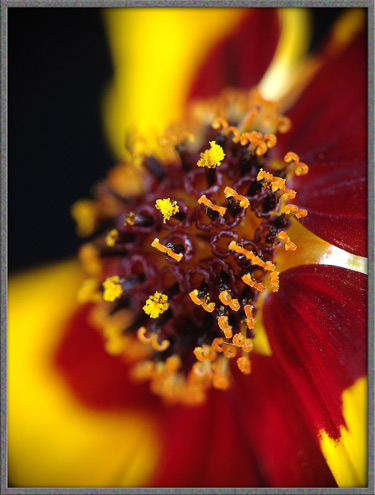
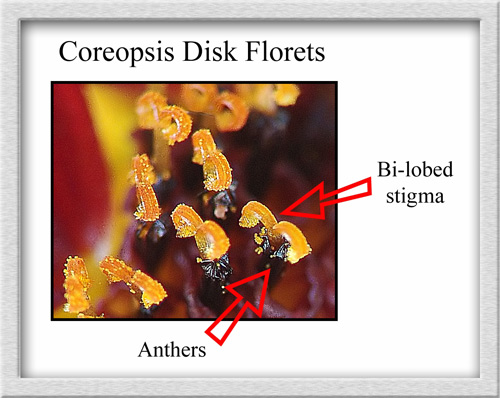
Another image showing these bi-lobed stigmas follows. The ray
florets have been removed to show the detail in one of the inner
phyllaries.
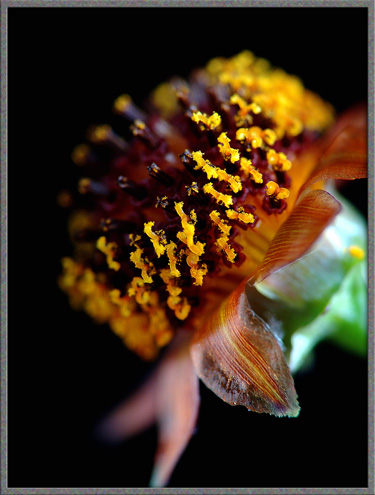
Under the microscope a stigma is an attractive orange-yellow colour,
and pollen grains are visible on its surface.
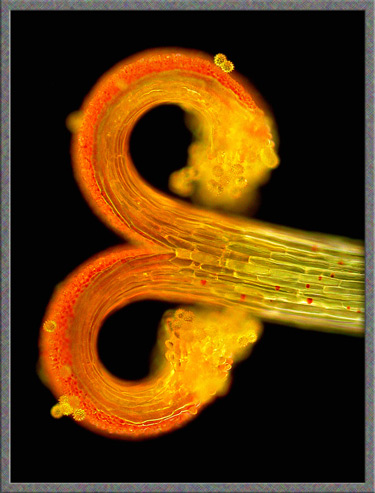
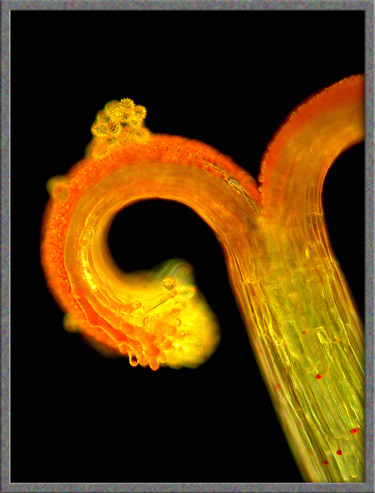
The bi-lobed stigma is held aloft by the style, a column that has randomly
located red spots on its component cells.
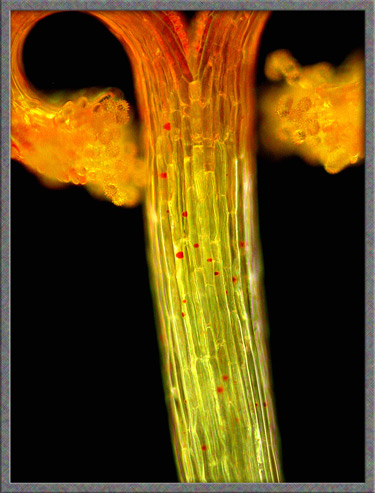
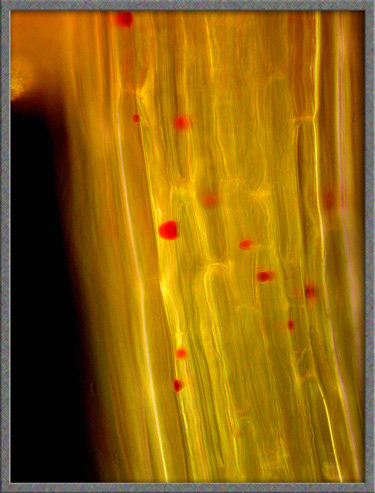
As the style ages, it becomes darker red, and the surface becomes
rougher.
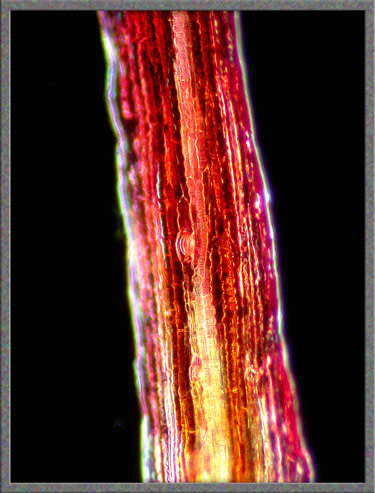
Earlier in the article, I mentioned the diversity in the colour of
blooms of Plains Coreopsis. In addition to the two colourations
shown earlier, some blooms are mostly red but speckled with yellow.
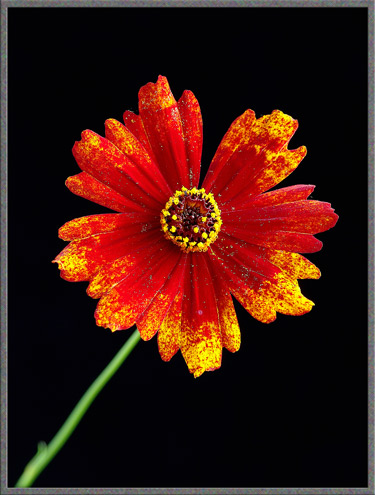
Some are almost completely red.
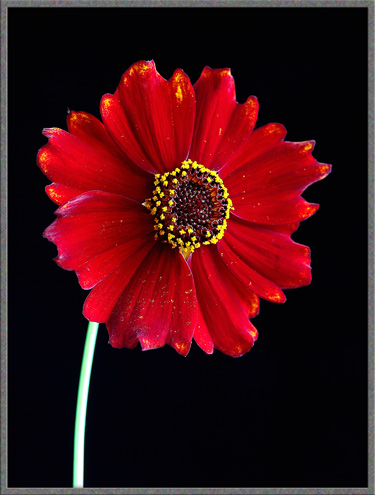
Others have no red at all outside of the central disk.
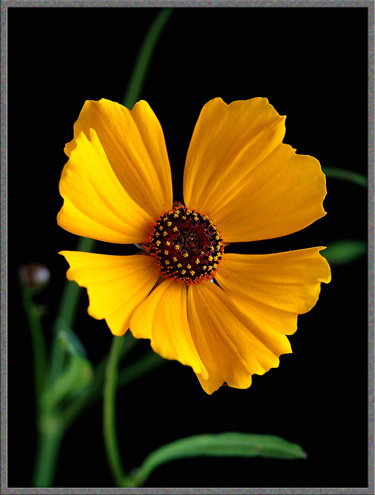
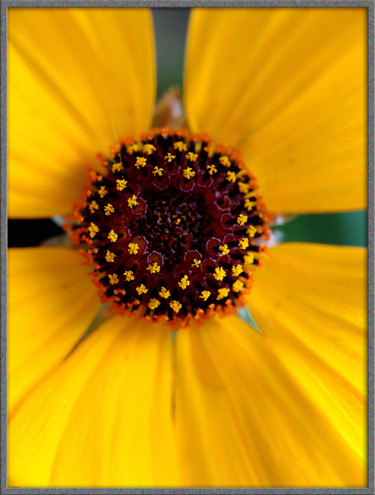
Plains Coreopsis is such an attractive wildflower that it is sometimes
used for landscape beautification along roadsides, and even in
gardens. Occasionally, the plant proliferates to such an extent
that it is considered a noxious weed. Where I live, the climate
is harsh enough to prevent such abundance, and finding these colourful
blooms is simply a pleasant happenstance!
Photographic Equipment
The photographs in the article were taken with an eight megapixel Sony
CyberShot DSC-F828 equipped with achromatic close-up lenses (Nikon 5T,
6T, Sony VCL-M3358, and shorter focal length achromat) used singly or
in combination. The lenses screw into the 58 mm filter threads of the
camera lens. (These produce a magnification of from 0.5X to 10X
for a 4x6 inch image.) Still higher magnifications were obtained
by using a macro coupler (which has two male threads) to attach a
reversed 50 mm focal length f1.4 Olympus SLR lens to the F828.
(The magnification here is about 14X for a 4x6 inch image.) The
photomicrographs were taken with a Leitz SM-Pol microscope (using a
dark ground condenser), and the Coolpix 4500.
References
The following references have been
found to be valuable in the identification of wildflowers, and they are
also a good source of information about them.
Published in the
October
2005 edition of Micscape.
Please report any Web problems or
offer general comments to the Micscape
Editor.
Micscape is the on-line monthly magazine
of the Microscopy UK web
site at Microscopy-UK
© Onview.net Ltd, Microscopy-UK, and all contributors 1995 onwards. All rights reserved. Main site is at www.microscopy-uk.org.uk with full mirror at www.microscopy-uk.net .